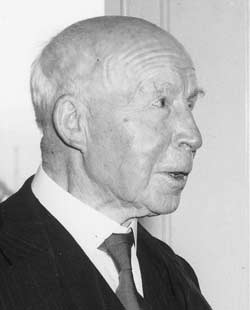LEO FANNING – A Reminiscence

New Zealand’s first hope of having a successful ironsand furnace was based on supplies from the coast of Taranaki. Year after year, E.M. Smith, M.P. of New Plymouth, pleaded for such an enterprise.
A paper-weight on my desk is a piece of iron from the first furnace, built in the backyard of his parents home in Dean Street, Christchurch, by Mr. J.E.L. Cull, an engineering graduate of Canterbury University.
He bought cheaply a small gas engine, a coffee mill for grinding coal and flux into fine dust, and a Rott’s blower. A ton of ironsand came from New Plymouth.
That little gas engine was a wonder-worker. It operated the coffee mill and powered a belt of magnetised mild steel which separated heavy iron-sand from light dross so that the concentrate could be fed into the plumbago crucible. It also provided power for the furnace blower.
Disappointments
There were many disappointments after hours of furious firing when anxious eyes gazed at the white-hot pour from the crucible. Persistence brought success — a pour of iron.
When I was drawn into the iron sand project I was junior sub-editor of the Lyttleton Times (now merged with the Christchurch Star).
With the prospect of becoming an assistant-metallurgist, I made good use of free afternoons for courses in geology and chemistry at Canterbury University. With more zeal than skill, I helped in various tasks.
Encouraging results from the furnace brought the need for reliable reports on deposits of iron sand, which had been vaguely exaggerated by Mr. Smith.
In January, 1905, I decided to use my annual holidays in a survey of the Taranaki iron sand beaches.
Won distinction
At Wellington, I was joined by Mr. S.H. Jenkinson, an engineering graduate of Canterbury University, whom I met there in my student years.
He was destined to win distinction as the designer of the Ab locomotive engine and as the author of "New Zealanders and Science", one of the New Zealand centennial surveys.
After his graduation, he had extensive experience in iron and steel works in the United States.
A big surprise lay in store for us at the head office of the Mines Department. We found astonishing ignorance of Taranaki ironsand. No survey of beaches and adjacent sand dunes had ever been made.
We went by train to Wanganui, to begin our trek on bicycles and on foot to the mouth of the Mokau River, nearly 60 miles from New Plymouth.
Specimens
Our equipment included about thirty small tins for samples of ironsand, a microscope of moderate power, a magnet, a sensitive set of scales for grading dry sand, a small scoop, a compass, maps and a small stove (fired by methylated spirit) for quick-drying of sand.
Collection of specimens began near the mouth of the Waitotara River, about 25 miles from Wanganui.
It was my nightly task in a village inn to dry the day’s ‘takes’, weigh them and peer at them through the microscope while Jenkinson read Swinburne, one of his favourite poets. That book was always with him.
All observations were carefully put in my diary, which was given to Mr Cull and lost after his death many years ago.
Ironsand beaches are bleak and dreary places. Shellfish do not thrive on them. However, they were pleasantly firm for cycling and walking.
"Alcoholics"
Between 5 and 6 p.m. we moved our cycles over a fence, rode on a highway, and stopped at the nearest inn. As we looked more like vagrants, the publican would always look doubtful, but take the risk of providing accommodation until after breakfast next morning.
Imagine the shock for one publican when a servant found a bottle of methylated spirit which I had forgotten to put in my pack. Of course, we would have been dubbed the worst sort of "alcoholics"
Before we began the return trek from Mokau a man told us we could cut out some miles of mucky road by riding along the beach to a gap where a creek came through steep papa cliffs.
Te Rauparaha, known as "the Maori Napoleon," led an army through the gap. We were warned against being overtaken by high tide, but somehow we made a mistake in our calculation. Water was above our knees when we were carrying our bicycles through the gap.
First Bicycle
We climbed into a Maori settlement of a wide flat. There we met a handsome young European teacher. She gave us a delightful feast of fried bacon and mushrooms and then asked us to ride the cycles — the first the Maori children had ever seen.
Our survey gave us good reasons for believing that the beach and dunes of the Patea district would yield the best quantities of ironsand.
The phase of that ironsand venture that disappointed many investors was the unsuccessful effort to win the confidence of moneyed people.
We were not worldly-wise in those days. We needed somebody with the knack of attracting capital, but we did not find him.
Demonstrations
Mr Cull gave satisfactory demonstrations to some iron-founders, and there was talk of possible developments but he could not live forever on hope. He had to resume earning his living.
He became a well-known designer of bridges and viaducts for the Public Works Department. Finally, he was professor of engineering at Canterbury University.
The Edison Company in America took over the specification of the magnetic separator.
FOOTNOTE: The New Zealand Steel Company’s main supplies of ironsand, in quality and quantity, will come from Waiuku, a few miles north of Port Waikato.
Back

|

